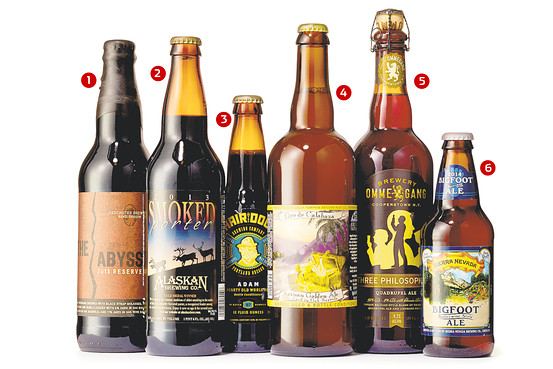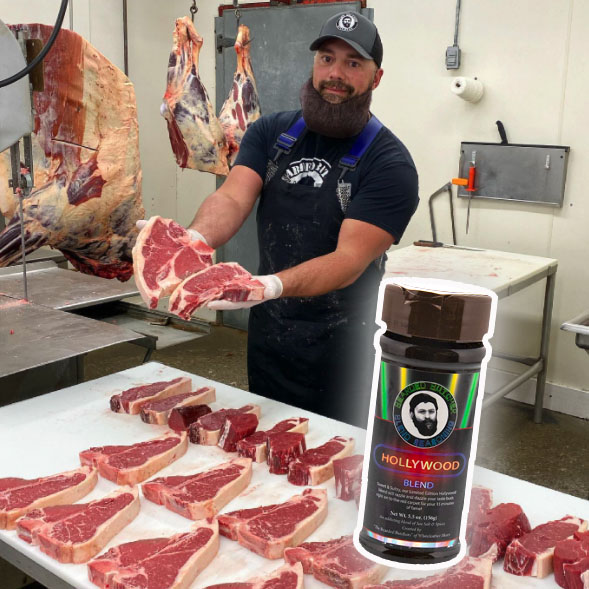By William Bostwick
Craft-brew aficionados are venturing into new territory: the cellar
ROOM WITH A BREW | At his home in Escondido, Calif., Bill Sysak of Stone Brewing Co. maintains a personal cellar of some 2,800 bottles. Lisa Corson for The Wall Street Journal
WHEN RUSSIAN RIVER released Pliny the Younger in February, 300 thirsty fans lined up outside the tiny Santa Rosa, Calif., brewpub for the first sip of this super-hoppy beer. Hop flavors fade fast, and for IPAs and even stronger Imperial IPAs like Pliny, fresh is best: It’s on tap once a year and runs dry in days. But as the screechingly hop-forward brews of the craft-beer movement’s first wave give way to deeper, more complex flavors, the revolution is moving down to the cellar. For some beer lovers, the best bottles aren’t the freshest, they’re the dustiest.
As with many of beer’s latest trends—limited editions, a preoccupation with terroir, cork-sealed bottles—this one takes cues from the wine world. At restaurants like San Francisco’s Abbot’s Cellar, the cicerones, beer’s equivalent of sommeliers, pour celebrated vintage brews like Baladin’s Port-like 2009 Xyauyù Etichetta Oro.
But amassing an all-star craft beer cellar doesn’t have to be a white-tablecloth endeavor price-wise. Great age-able beers can be quite affordable. A six-pack of Sierra Nevada’s Bigfoot—a spicy barley wine that turns as syrupy as sweet Sherry after a few years—goes for about $12.
“ Since most of these beers are relatively affordable, buy a bunch and open one from time to time. After a few years, try a vertical tasting: one beer, different ages. ”
Still, you can’t buy just anything and lay it down to age. Not all beers get better with time. Hop-driven IPAs lose their kick quickly as light, heat and oxygen degrade the flavorful flowers’ acids and oils. Stone Brewing Co.’s Enjoy By IPA touts its bottled-on date as a badge, and the brewery’s cicerone, Bill Sysak, recommends immediate consumption. Instead, Mr. Sysak stocks his personal cellar—2,800 bottles and counting—with strong, dark and bottle-conditioned beers. The sometimes overpowering fusel alcohol notes of stronger beers, 8% ABV (alcohol by volume) and up, mellow over time; living yeast in bottle-conditioned beers adds character as it continues to ferment residual sugars.
Aging craft beer are truly an adventure. Sweet, bottle-conditioned Belgians dry out; fiery barley wines turn smooth and caramelly. Stone’s Imperial Russian Stout, Mr. Sysak said, “might be astringent, fresh, like espresso. But aged, it’s a delicious chocolate-coffee dessert.” One of the oldest he’s tried, a 1968 Thomas Hardy’s Ale, “was like an Oloroso Sherry: nuts, toffee, leather and smoke.”
Craft Beer may be strong, but they must be aged gently. Aim for 54 degrees Fahrenheit—a mini-fridge with a temperature control is nice, but a dark interior closet works too. Mr. Sysak found a sweet spot in his guest bathroom. “People would open the cupboard and find all these rare bottles,” he said. Above all, you want consistency. Temperature fluctuations will age beer prematurely and might throw its proteins out of solution, turning the brew hazy.
There’s no need to bother with horizontal storage, even with cork-sealed beers. Most modern corks are treated with wax so they won’t dry out, and vertical storage minimizes contact between the beer and air in the bottle, slowing the aging process.
The biggest question is when to drink. Allagash recommends about three years for a Belgian brew like its Interlude, bready and tannic. Alaskan Brewing Co.’s Smoked Porter—thought up by brewery founder Geoff Larson over a plate of lox with a salmon-curing neighbor—”hasn’t peaked yet,” said Mr. Larson. Since most of these beers are relatively affordable, buy a bunch and open one from time to time. After a few years, try a vertical tasting: one beer, different ages. Start with the oldest bottle and proceed chronologically, so the younger batch’s more intense flavors don’t overwhelm your palate at the outset. And, as with wine, sip and savor. Tasting, like aging, takes patience. “Drinking these beers is like getting into a hot tub,” Mr. Larson said. “Go slowwww.”
The Craft Beer Starter Kit – Beers to hold on to


1. Deschutes The Abyss; 2. Alaskan Brewing Co. Smoked Porter; 3. Hair of the Dog Adam; 4. Jolly Pumpkin Oro de Calabaza; 5. Ommegang Three Philosophers; 6. Sierra Nevada Bigfoot F. Martin Ramin/The Wall Street Journal
1. Deschutes The Abyss, 11% ABV
This pitch-black imperial stout is devilishly smooth, even when young; given time, tannic molasses turns to rich chocolate, licorice spice to soothing plum pudding.
2. Alaskan Brewing Co. Smoked Porter, 6.5% ABV
After a few years, the alder smoke turns richer and less sharp, the dark malt gets syrupy sweet and a bracing cold-night nip becomes a warming frontiersman’s breakfast redolent of maple-cured bacon.
3. Hair of the Dog Adam, 10% ABV
A boisterous roomful of distinct flavors when fresh—dark chocolate, espresso, a wisp of cigar smoke, cacophonous and loud. A year’s rest or more trains those voices into a warmly lilting chorus.
4. Jolly Pumpkin Oro de Calabaza, 8% ABV
A straw-hued, bottle-conditioned brew, aged in barrels with a bit of wild yeast, Jolly Pumpkin’s flagship starts perfect and only gets better—sliding from sweet, fruity golden raisins to zesty dry Champagne.
5. Ommegang Three Philosophers, 9.7%
Young, this strong blonde Belgian quadruple is sweet and hot, rum soaked cherries and caramelized figs. Bottled with a bit of live yeast, it’ll dry out in time, honing a sharp, peppery edge.
6. Sierra Nevada Bigfoot, 9.6% ABV
A British-style strong beer, or barley wine, with a decidedly American hop-centric twist. Viscous with Chinook hops’ throat-coating pine and citrus resin, this monster sweetens into old age.

